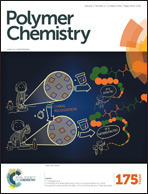Thermoresponsive gels based on ABC triblock copolymers: effect of the length of the PEG side group†
Abstract
In this study, one statistical and nine well-defined ABC triblock thermoresponsive terpolymers were synthesised via group transfer polymerisation (GTP). The A, B, and C blocks were based on poly(ethylene glycol) (PEG) based methacrylate, n-butyl methacrylate (BuMA), and 2-(dimethylamino)ethyl methacrylate (DMAEMA), respectively. The length of the PEG side group was varied. Specifically, three different PEG based monomers were used: methoxy di-, penta-, and nona(ethylene glycol) methacrylate (DEGMA, PEGMA, and NEGMA, respectively). Along with the length of the PEG side group, the composition of the terpolymers was also systematically varied in order to investigate the effect of both these parameters on the thermoresponsive behaviour of the polymers. The molar mass (MM) and the architecture were kept the same. Their hydrodynamic diameters, the effective pKas, and the cloud points of aqueous copolymer solutions were determined by dynamic light scattering (DLS), potentiometric titrations, and visual tests, respectively. Micelle formation was observed for all the copolymers and the pKas were influenced by the hydrophobic content but not by the PEG side length. On the other hand both the composition and the PEG side chain length affected the cloud points and the sol–gel transition. In summary, it was demonstrated that the sol–gel transition can be tailored by varying both the PEG length as well as the composition of the polymers.


 Please wait while we load your content...
Please wait while we load your content...